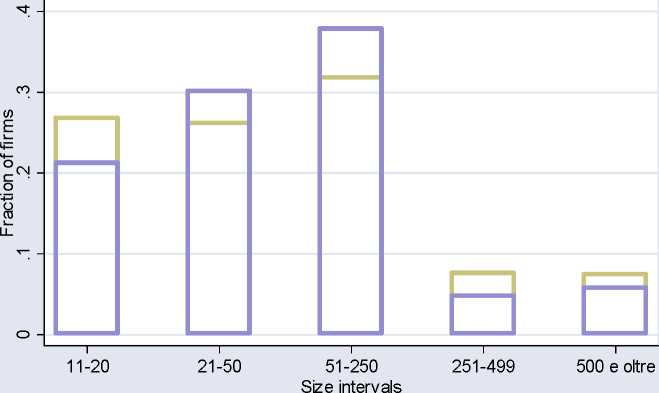Appendix
We control for sample selection that could actually come up when Capitalia-Unicredit IX survey
data are matched with AIDA balance sheet of firms present in 2007. Not all Capitalia firms exist in
AIDA register. Nonetheless, we manage to retain almost 86% of the Capitalia sample. Therefore,
we check in what type of characteristics do firms in-sample and out-of-sample differ.
Figure A 1. In and Out Sample distribution of Capitalia firms by size
Firm distribution by number of workers in and out-sample

∣^~^~∣ out-of-sample in-sample
Figure A1 shows the distribution by class of workers of the firms falling in and out of our final
panel. The panel tends to maintain medium size firms mainly (87%), while keeping around 79% of
the medium-large and large firms. As far as the very small firms, our panel keeps 82% of them.
Formally, the test for independence hypothesis rejects the null (Pearson chi-square(4) = 25.7455, p-
value = 0.000) meaning that being in or out of sample depends in a certain way on firm size.
We lose 15.6% of firms located in North-West part of Italy (Lombardia, Piemonte, Liguria, Valle
d’Aosta), 13.9% of the firms located in the North-East (Trentino A.A., Veneto, Friuli V.G., Emilia
Romagna), 13.5% of the firms located in the Centre (Toscana, Umbria, Marche, Lazio) and 15.8%
of the firms located in the South. The Pearson chi-square(4) = 3.4150 with p-value = 0.491 says that
there is statistical independence between the regional distribution and being in or out of sample.
29
More intriguing information
1. Incorporating global skills within UK higher education of engineers2. Education Responses to Climate Change and Quality: Two Parts of the Same Agenda?
3. Review of “The Hesitant Hand: Taming Self-Interest in the History of Economic Ideas”
4. The name is absent
5. Lending to Agribusinesses in Zambia
6. If our brains were simple, we would be too simple to understand them.
7. The name is absent
8. Prizes and Patents: Using Market Signals to Provide Incentives for Innovations
9. Stakeholder Activism, Managerial Entrenchment, and the Congruence of Interests between Shareholders and Stakeholders
10. CAPACITAÇÃO GERENCIAL DE AGRICULTORES FAMILIARES: UMA PROPOSTA METODOLÓGICA DE EXTENSÃO RURAL